Improving Australian Diets: Analysis of Citizen Jury Report
VerifiedAdded on 2023/06/11
|8
|2034
|53
Report
AI Summary
This report analyzes the recommendations made by the Citizen's Jury on Obesity regarding strategies to facilitate healthier eating habits among Australians. It focuses on two key recommendations: providing low-income individuals with access to discounted healthy foods and mandating Health Star Labelling on all packaged products. The report argues that reducing the cost of healthy food in rural and remote areas can significantly improve the diets of low-income groups, who are disproportionately affected by overweight and obesity due to their reliance on cheaper, nutrient-poor foods. Additionally, the report emphasizes the importance of Health Star Labelling as a tool to empower consumers to make informed choices about packaged foods by easily comparing their nutritional profiles. By implementing these recommendations, the Australian government can promote healthier lifestyles, prevent chronic diseases, and reduce healthcare costs associated with poor dietary habits.

How Can We Make It Easier For Australians To Eat Better
Paraphrase This Document
Need a fresh take? Get an instant paraphrase of this document with our AI Paraphraser
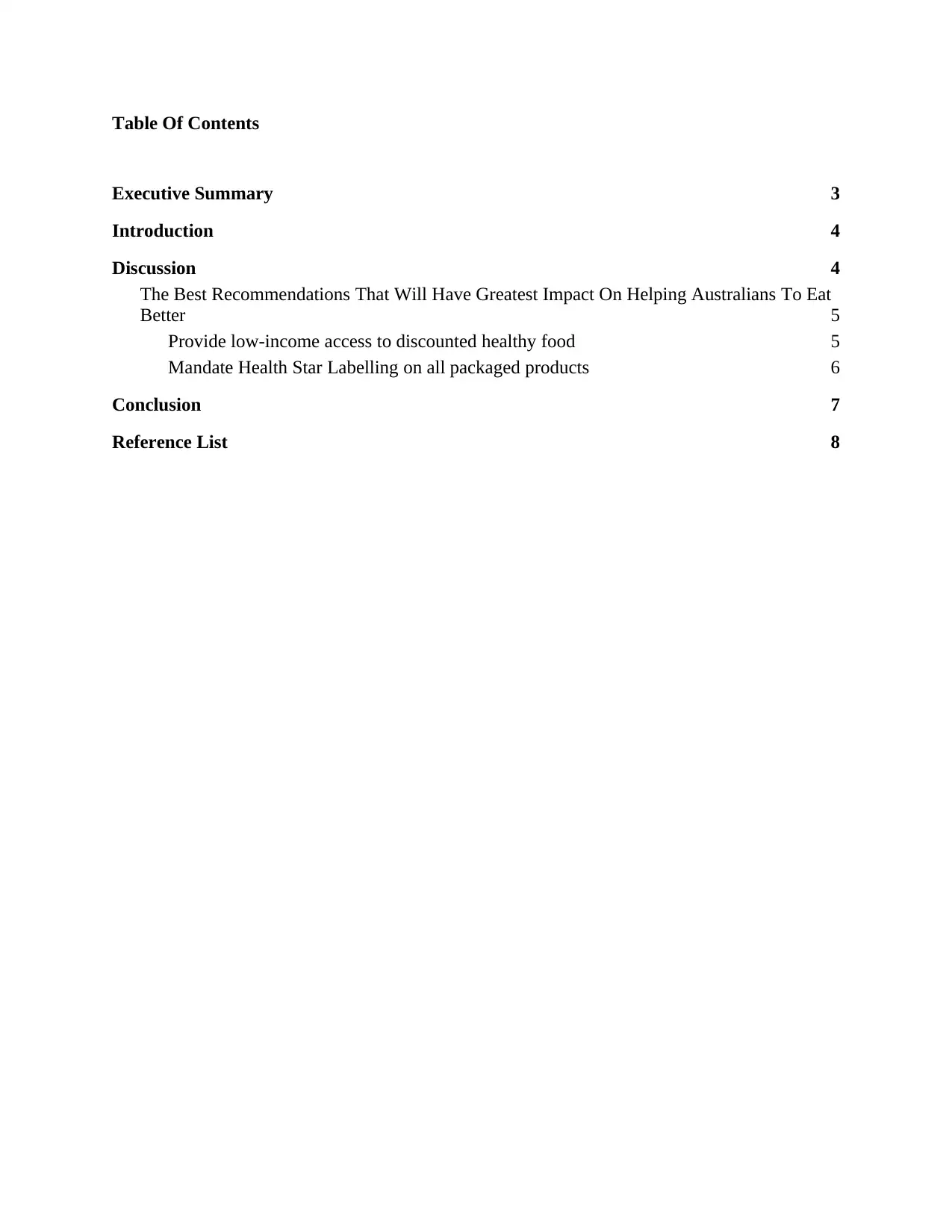
Table Of Contents
Executive Summary 3
Introduction 4
Discussion 4
The Best Recommendations That Will Have Greatest Impact On Helping Australians To Eat
Better 5
Provide low-income access to discounted healthy food 5
Mandate Health Star Labelling on all packaged products 6
Conclusion 7
Reference List 8
Executive Summary 3
Introduction 4
Discussion 4
The Best Recommendations That Will Have Greatest Impact On Helping Australians To Eat
Better 5
Provide low-income access to discounted healthy food 5
Mandate Health Star Labelling on all packaged products 6
Conclusion 7
Reference List 8
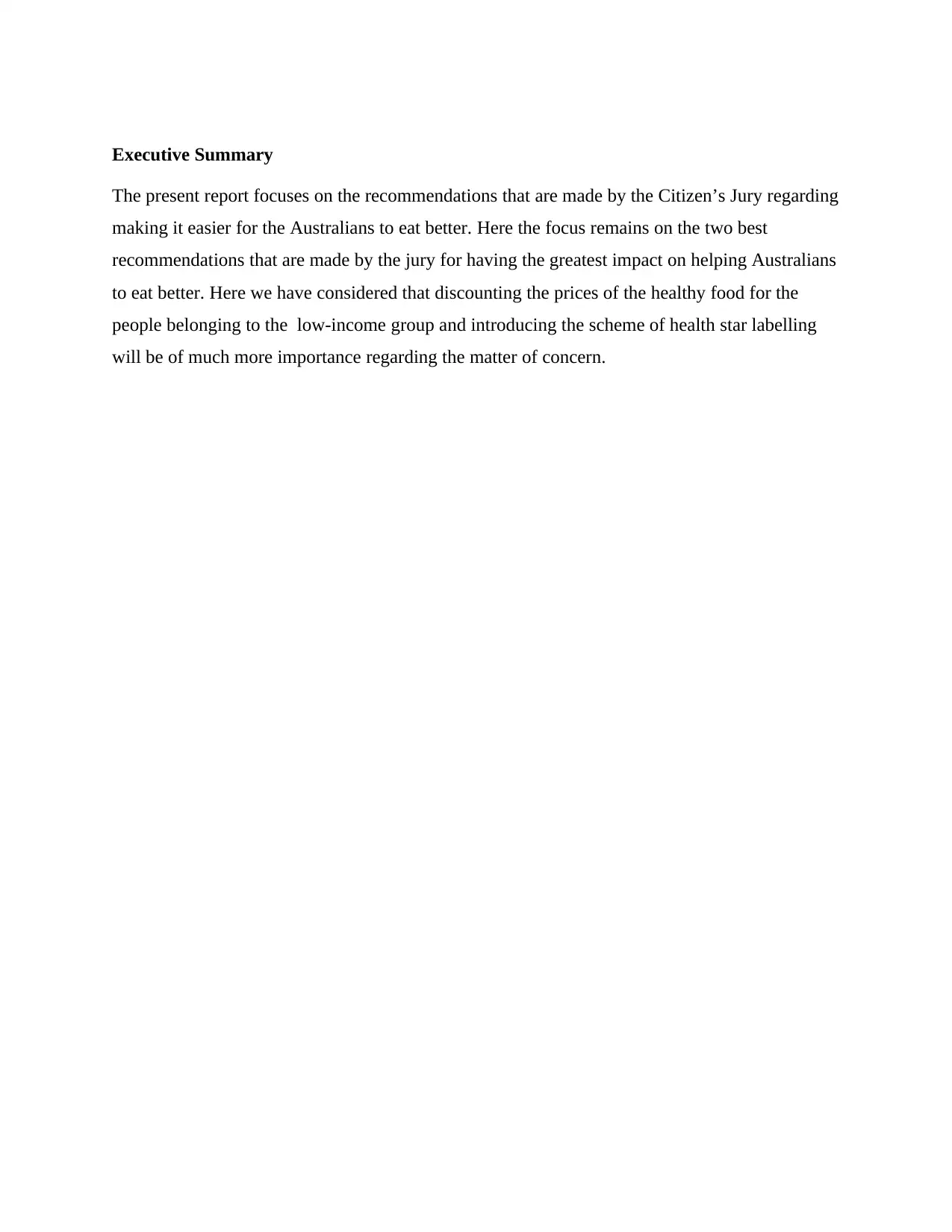
Executive Summary
The present report focuses on the recommendations that are made by the Citizen’s Jury regarding
making it easier for the Australians to eat better. Here the focus remains on the two best
recommendations that are made by the jury for having the greatest impact on helping Australians
to eat better. Here we have considered that discounting the prices of the healthy food for the
people belonging to the low-income group and introducing the scheme of health star labelling
will be of much more importance regarding the matter of concern.
The present report focuses on the recommendations that are made by the Citizen’s Jury regarding
making it easier for the Australians to eat better. Here the focus remains on the two best
recommendations that are made by the jury for having the greatest impact on helping Australians
to eat better. Here we have considered that discounting the prices of the healthy food for the
people belonging to the low-income group and introducing the scheme of health star labelling
will be of much more importance regarding the matter of concern.
⊘ This is a preview!⊘
Do you want full access?
Subscribe today to unlock all pages.

Trusted by 1+ million students worldwide
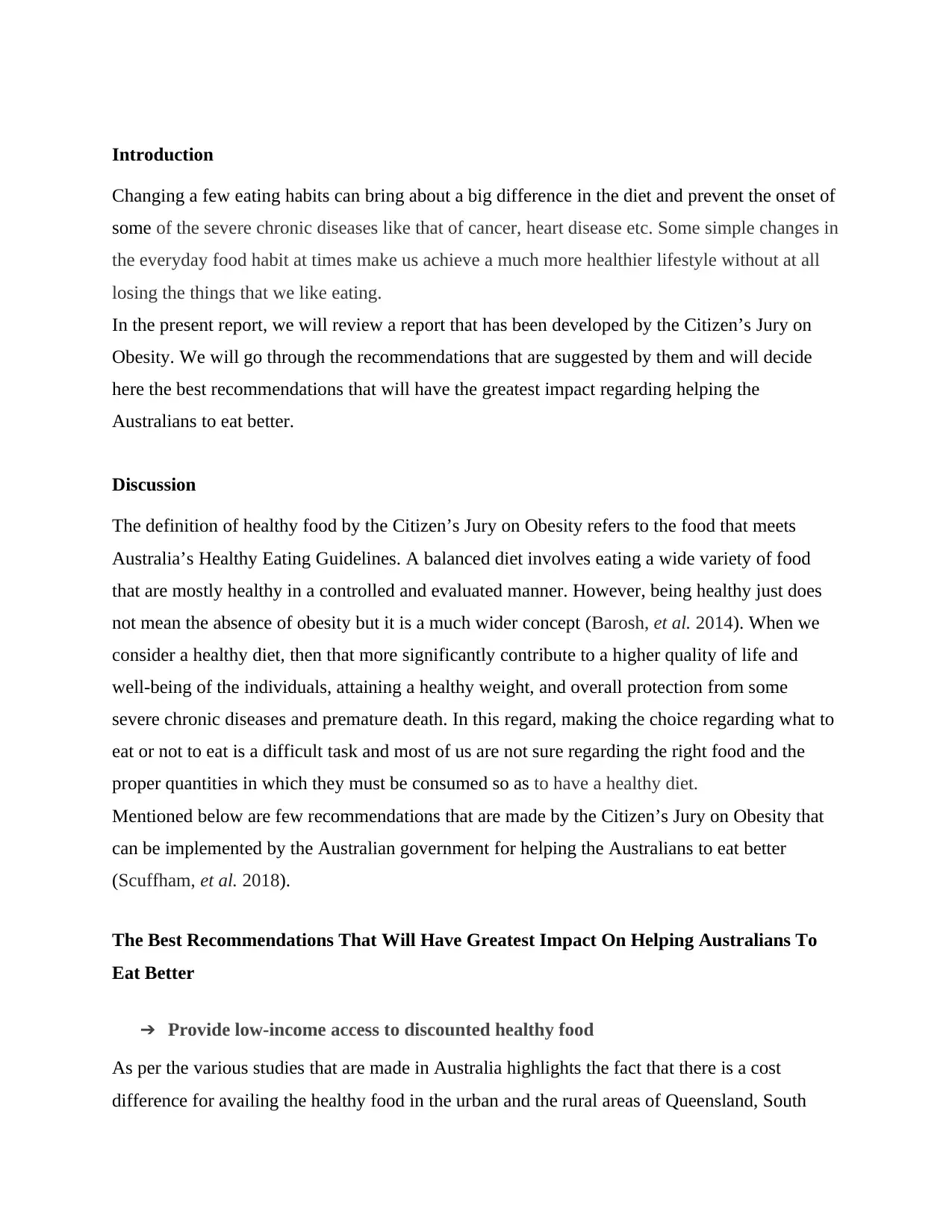
Introduction
Changing a few eating habits can bring about a big difference in the diet and prevent the onset of
some of the severe chronic diseases like that of cancer, heart disease etc. Some simple changes in
the everyday food habit at times make us achieve a much more healthier lifestyle without at all
losing the things that we like eating.
In the present report, we will review a report that has been developed by the Citizen’s Jury on
Obesity. We will go through the recommendations that are suggested by them and will decide
here the best recommendations that will have the greatest impact regarding helping the
Australians to eat better.
Discussion
The definition of healthy food by the Citizen’s Jury on Obesity refers to the food that meets
Australia’s Healthy Eating Guidelines. A balanced diet involves eating a wide variety of food
that are mostly healthy in a controlled and evaluated manner. However, being healthy just does
not mean the absence of obesity but it is a much wider concept (Barosh, et al. 2014). When we
consider a healthy diet, then that more significantly contribute to a higher quality of life and
well-being of the individuals, attaining a healthy weight, and overall protection from some
severe chronic diseases and premature death. In this regard, making the choice regarding what to
eat or not to eat is a difficult task and most of us are not sure regarding the right food and the
proper quantities in which they must be consumed so as to have a healthy diet.
Mentioned below are few recommendations that are made by the Citizen’s Jury on Obesity that
can be implemented by the Australian government for helping the Australians to eat better
(Scuffham, et al. 2018).
The Best Recommendations That Will Have Greatest Impact On Helping Australians To
Eat Better
➔ Provide low-income access to discounted healthy food
As per the various studies that are made in Australia highlights the fact that there is a cost
difference for availing the healthy food in the urban and the rural areas of Queensland, South
Changing a few eating habits can bring about a big difference in the diet and prevent the onset of
some of the severe chronic diseases like that of cancer, heart disease etc. Some simple changes in
the everyday food habit at times make us achieve a much more healthier lifestyle without at all
losing the things that we like eating.
In the present report, we will review a report that has been developed by the Citizen’s Jury on
Obesity. We will go through the recommendations that are suggested by them and will decide
here the best recommendations that will have the greatest impact regarding helping the
Australians to eat better.
Discussion
The definition of healthy food by the Citizen’s Jury on Obesity refers to the food that meets
Australia’s Healthy Eating Guidelines. A balanced diet involves eating a wide variety of food
that are mostly healthy in a controlled and evaluated manner. However, being healthy just does
not mean the absence of obesity but it is a much wider concept (Barosh, et al. 2014). When we
consider a healthy diet, then that more significantly contribute to a higher quality of life and
well-being of the individuals, attaining a healthy weight, and overall protection from some
severe chronic diseases and premature death. In this regard, making the choice regarding what to
eat or not to eat is a difficult task and most of us are not sure regarding the right food and the
proper quantities in which they must be consumed so as to have a healthy diet.
Mentioned below are few recommendations that are made by the Citizen’s Jury on Obesity that
can be implemented by the Australian government for helping the Australians to eat better
(Scuffham, et al. 2018).
The Best Recommendations That Will Have Greatest Impact On Helping Australians To
Eat Better
➔ Provide low-income access to discounted healthy food
As per the various studies that are made in Australia highlights the fact that there is a cost
difference for availing the healthy food in the urban and the rural areas of Queensland, South
Paraphrase This Document
Need a fresh take? Get an instant paraphrase of this document with our AI Paraphraser
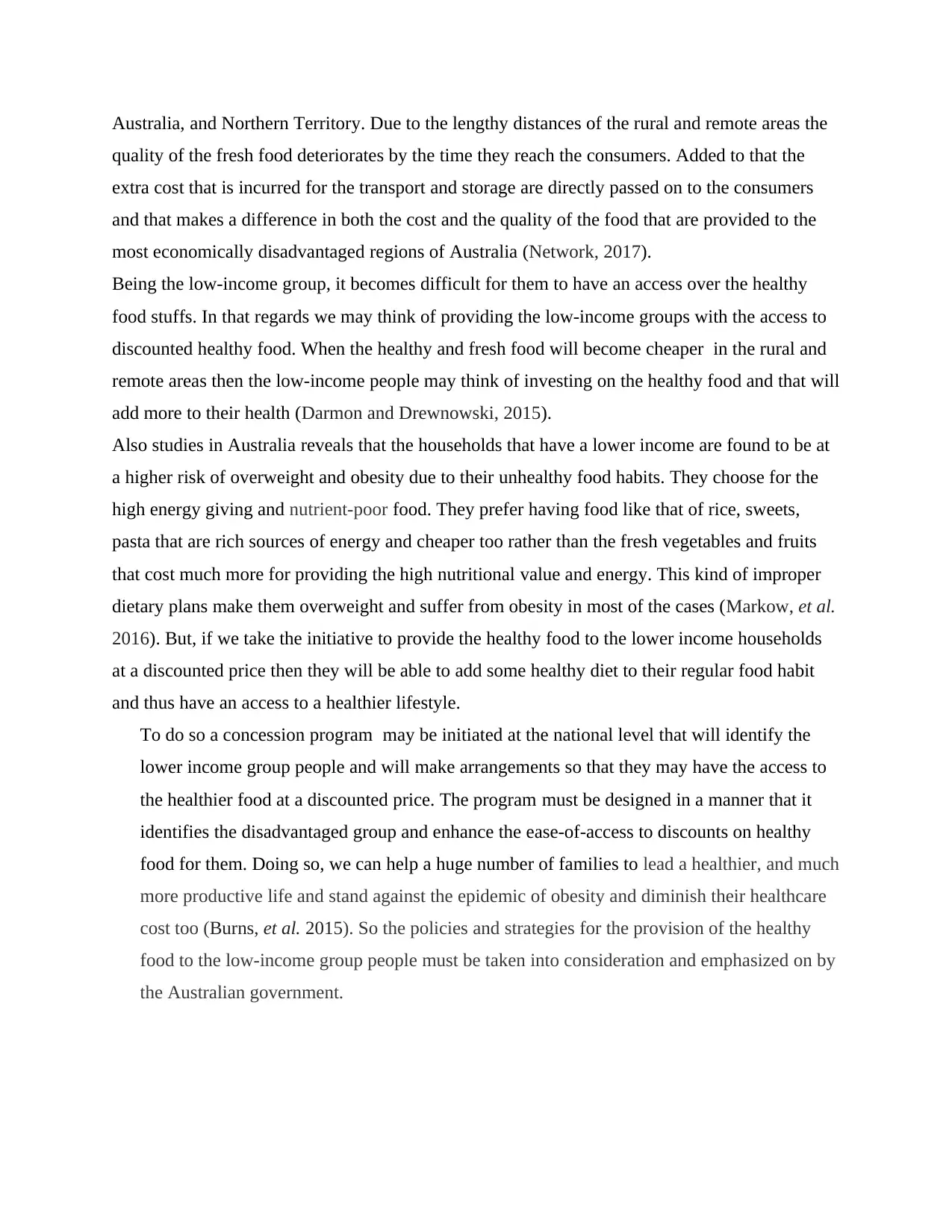
Australia, and Northern Territory. Due to the lengthy distances of the rural and remote areas the
quality of the fresh food deteriorates by the time they reach the consumers. Added to that the
extra cost that is incurred for the transport and storage are directly passed on to the consumers
and that makes a difference in both the cost and the quality of the food that are provided to the
most economically disadvantaged regions of Australia (Network, 2017).
Being the low-income group, it becomes difficult for them to have an access over the healthy
food stuffs. In that regards we may think of providing the low-income groups with the access to
discounted healthy food. When the healthy and fresh food will become cheaper in the rural and
remote areas then the low-income people may think of investing on the healthy food and that will
add more to their health (Darmon and Drewnowski, 2015).
Also studies in Australia reveals that the households that have a lower income are found to be at
a higher risk of overweight and obesity due to their unhealthy food habits. They choose for the
high energy giving and nutrient-poor food. They prefer having food like that of rice, sweets,
pasta that are rich sources of energy and cheaper too rather than the fresh vegetables and fruits
that cost much more for providing the high nutritional value and energy. This kind of improper
dietary plans make them overweight and suffer from obesity in most of the cases (Markow, et al.
2016). But, if we take the initiative to provide the healthy food to the lower income households
at a discounted price then they will be able to add some healthy diet to their regular food habit
and thus have an access to a healthier lifestyle.
To do so a concession program may be initiated at the national level that will identify the
lower income group people and will make arrangements so that they may have the access to
the healthier food at a discounted price. The program must be designed in a manner that it
identifies the disadvantaged group and enhance the ease-of-access to discounts on healthy
food for them. Doing so, we can help a huge number of families to lead a healthier, and much
more productive life and stand against the epidemic of obesity and diminish their healthcare
cost too (Burns, et al. 2015). So the policies and strategies for the provision of the healthy
food to the low-income group people must be taken into consideration and emphasized on by
the Australian government.
quality of the fresh food deteriorates by the time they reach the consumers. Added to that the
extra cost that is incurred for the transport and storage are directly passed on to the consumers
and that makes a difference in both the cost and the quality of the food that are provided to the
most economically disadvantaged regions of Australia (Network, 2017).
Being the low-income group, it becomes difficult for them to have an access over the healthy
food stuffs. In that regards we may think of providing the low-income groups with the access to
discounted healthy food. When the healthy and fresh food will become cheaper in the rural and
remote areas then the low-income people may think of investing on the healthy food and that will
add more to their health (Darmon and Drewnowski, 2015).
Also studies in Australia reveals that the households that have a lower income are found to be at
a higher risk of overweight and obesity due to their unhealthy food habits. They choose for the
high energy giving and nutrient-poor food. They prefer having food like that of rice, sweets,
pasta that are rich sources of energy and cheaper too rather than the fresh vegetables and fruits
that cost much more for providing the high nutritional value and energy. This kind of improper
dietary plans make them overweight and suffer from obesity in most of the cases (Markow, et al.
2016). But, if we take the initiative to provide the healthy food to the lower income households
at a discounted price then they will be able to add some healthy diet to their regular food habit
and thus have an access to a healthier lifestyle.
To do so a concession program may be initiated at the national level that will identify the
lower income group people and will make arrangements so that they may have the access to
the healthier food at a discounted price. The program must be designed in a manner that it
identifies the disadvantaged group and enhance the ease-of-access to discounts on healthy
food for them. Doing so, we can help a huge number of families to lead a healthier, and much
more productive life and stand against the epidemic of obesity and diminish their healthcare
cost too (Burns, et al. 2015). So the policies and strategies for the provision of the healthy
food to the low-income group people must be taken into consideration and emphasized on by
the Australian government.
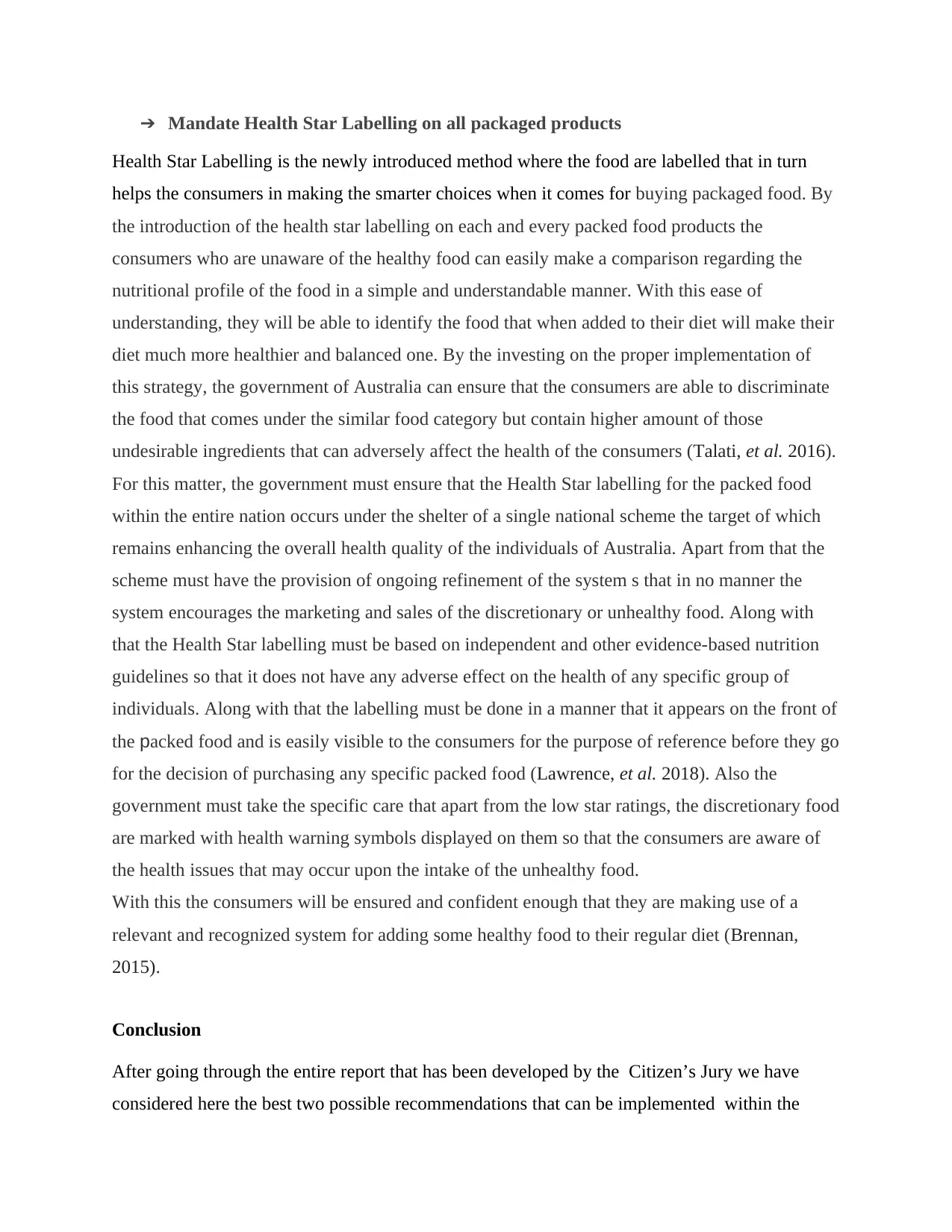
➔ Mandate Health Star Labelling on all packaged products
Health Star Labelling is the newly introduced method where the food are labelled that in turn
helps the consumers in making the smarter choices when it comes for buying packaged food. By
the introduction of the health star labelling on each and every packed food products the
consumers who are unaware of the healthy food can easily make a comparison regarding the
nutritional profile of the food in a simple and understandable manner. With this ease of
understanding, they will be able to identify the food that when added to their diet will make their
diet much more healthier and balanced one. By the investing on the proper implementation of
this strategy, the government of Australia can ensure that the consumers are able to discriminate
the food that comes under the similar food category but contain higher amount of those
undesirable ingredients that can adversely affect the health of the consumers (Talati, et al. 2016).
For this matter, the government must ensure that the Health Star labelling for the packed food
within the entire nation occurs under the shelter of a single national scheme the target of which
remains enhancing the overall health quality of the individuals of Australia. Apart from that the
scheme must have the provision of ongoing refinement of the system s that in no manner the
system encourages the marketing and sales of the discretionary or unhealthy food. Along with
that the Health Star labelling must be based on independent and other evidence-based nutrition
guidelines so that it does not have any adverse effect on the health of any specific group of
individuals. Along with that the labelling must be done in a manner that it appears on the front of
the packed food and is easily visible to the consumers for the purpose of reference before they go
for the decision of purchasing any specific packed food (Lawrence, et al. 2018). Also the
government must take the specific care that apart from the low star ratings, the discretionary food
are marked with health warning symbols displayed on them so that the consumers are aware of
the health issues that may occur upon the intake of the unhealthy food.
With this the consumers will be ensured and confident enough that they are making use of a
relevant and recognized system for adding some healthy food to their regular diet (Brennan,
2015).
Conclusion
After going through the entire report that has been developed by the Citizen’s Jury we have
considered here the best two possible recommendations that can be implemented within the
Health Star Labelling is the newly introduced method where the food are labelled that in turn
helps the consumers in making the smarter choices when it comes for buying packaged food. By
the introduction of the health star labelling on each and every packed food products the
consumers who are unaware of the healthy food can easily make a comparison regarding the
nutritional profile of the food in a simple and understandable manner. With this ease of
understanding, they will be able to identify the food that when added to their diet will make their
diet much more healthier and balanced one. By the investing on the proper implementation of
this strategy, the government of Australia can ensure that the consumers are able to discriminate
the food that comes under the similar food category but contain higher amount of those
undesirable ingredients that can adversely affect the health of the consumers (Talati, et al. 2016).
For this matter, the government must ensure that the Health Star labelling for the packed food
within the entire nation occurs under the shelter of a single national scheme the target of which
remains enhancing the overall health quality of the individuals of Australia. Apart from that the
scheme must have the provision of ongoing refinement of the system s that in no manner the
system encourages the marketing and sales of the discretionary or unhealthy food. Along with
that the Health Star labelling must be based on independent and other evidence-based nutrition
guidelines so that it does not have any adverse effect on the health of any specific group of
individuals. Along with that the labelling must be done in a manner that it appears on the front of
the packed food and is easily visible to the consumers for the purpose of reference before they go
for the decision of purchasing any specific packed food (Lawrence, et al. 2018). Also the
government must take the specific care that apart from the low star ratings, the discretionary food
are marked with health warning symbols displayed on them so that the consumers are aware of
the health issues that may occur upon the intake of the unhealthy food.
With this the consumers will be ensured and confident enough that they are making use of a
relevant and recognized system for adding some healthy food to their regular diet (Brennan,
2015).
Conclusion
After going through the entire report that has been developed by the Citizen’s Jury we have
considered here the best two possible recommendations that can be implemented within the
⊘ This is a preview!⊘
Do you want full access?
Subscribe today to unlock all pages.

Trusted by 1+ million students worldwide
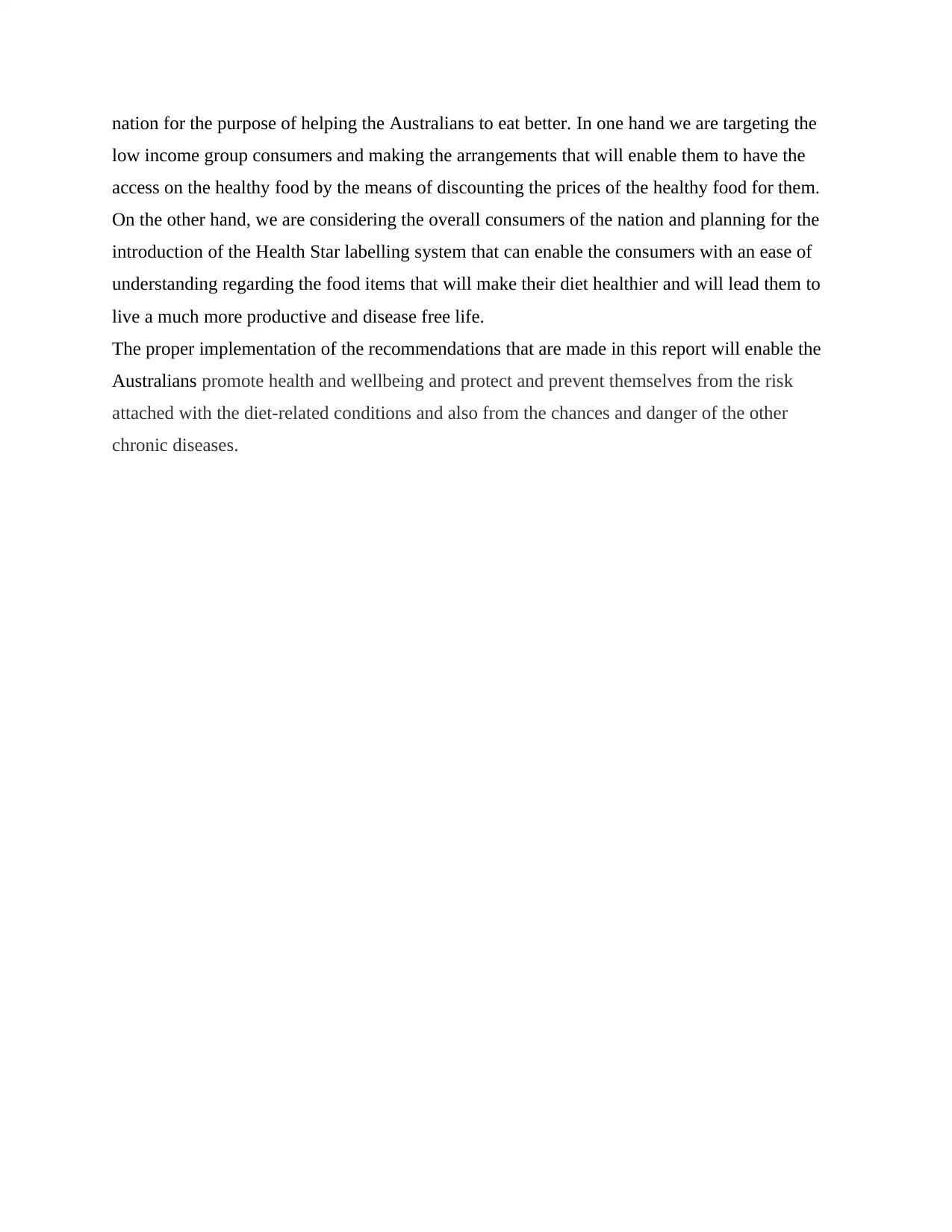
nation for the purpose of helping the Australians to eat better. In one hand we are targeting the
low income group consumers and making the arrangements that will enable them to have the
access on the healthy food by the means of discounting the prices of the healthy food for them.
On the other hand, we are considering the overall consumers of the nation and planning for the
introduction of the Health Star labelling system that can enable the consumers with an ease of
understanding regarding the food items that will make their diet healthier and will lead them to
live a much more productive and disease free life.
The proper implementation of the recommendations that are made in this report will enable the
Australians promote health and wellbeing and protect and prevent themselves from the risk
attached with the diet-related conditions and also from the chances and danger of the other
chronic diseases.
low income group consumers and making the arrangements that will enable them to have the
access on the healthy food by the means of discounting the prices of the healthy food for them.
On the other hand, we are considering the overall consumers of the nation and planning for the
introduction of the Health Star labelling system that can enable the consumers with an ease of
understanding regarding the food items that will make their diet healthier and will lead them to
live a much more productive and disease free life.
The proper implementation of the recommendations that are made in this report will enable the
Australians promote health and wellbeing and protect and prevent themselves from the risk
attached with the diet-related conditions and also from the chances and danger of the other
chronic diseases.
Paraphrase This Document
Need a fresh take? Get an instant paraphrase of this document with our AI Paraphraser
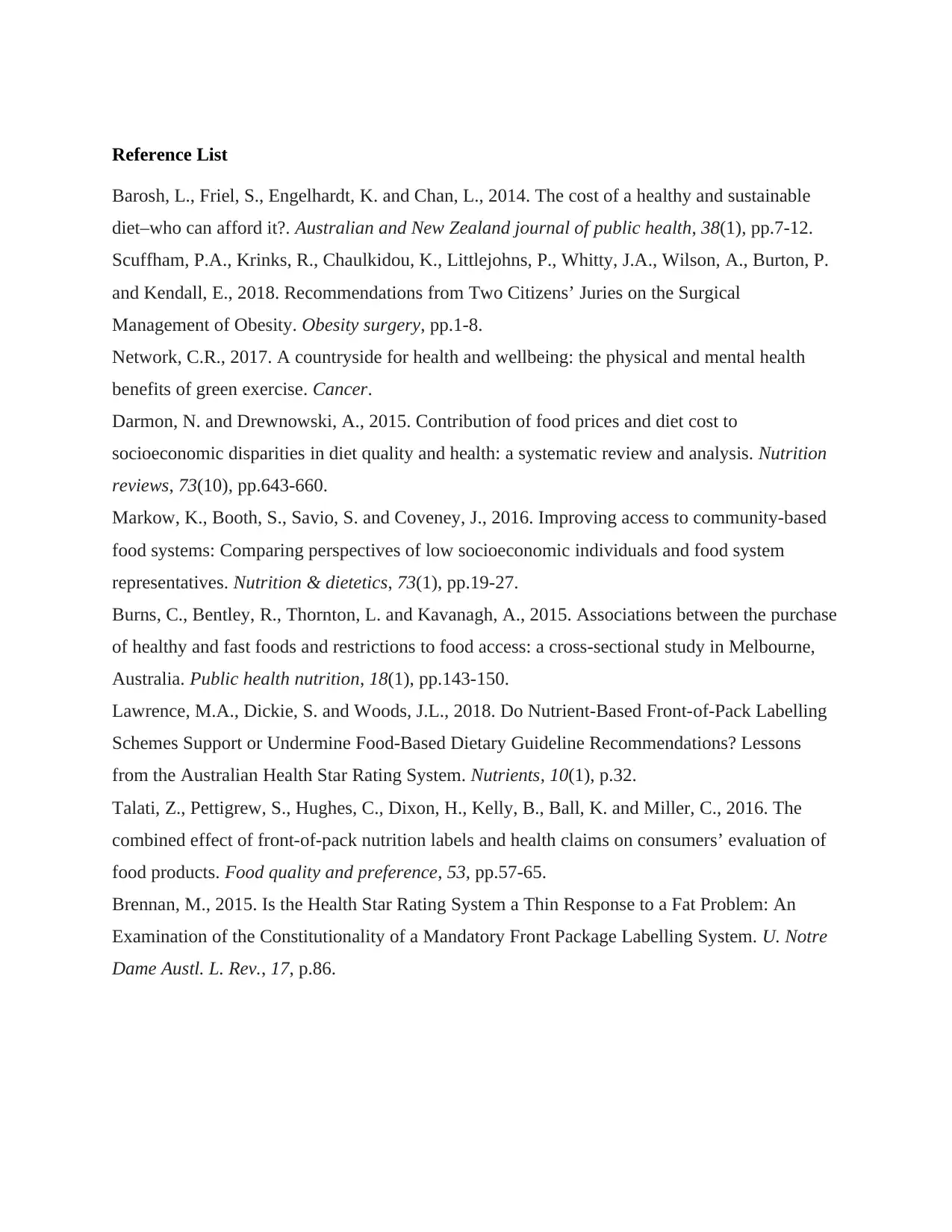
Reference List
Barosh, L., Friel, S., Engelhardt, K. and Chan, L., 2014. The cost of a healthy and sustainable
diet–who can afford it?. Australian and New Zealand journal of public health, 38(1), pp.7-12.
Scuffham, P.A., Krinks, R., Chaulkidou, K., Littlejohns, P., Whitty, J.A., Wilson, A., Burton, P.
and Kendall, E., 2018. Recommendations from Two Citizens’ Juries on the Surgical
Management of Obesity. Obesity surgery, pp.1-8.
Network, C.R., 2017. A countryside for health and wellbeing: the physical and mental health
benefits of green exercise. Cancer.
Darmon, N. and Drewnowski, A., 2015. Contribution of food prices and diet cost to
socioeconomic disparities in diet quality and health: a systematic review and analysis. Nutrition
reviews, 73(10), pp.643-660.
Markow, K., Booth, S., Savio, S. and Coveney, J., 2016. Improving access to community‐based
food systems: Comparing perspectives of low socioeconomic individuals and food system
representatives. Nutrition & dietetics, 73(1), pp.19-27.
Burns, C., Bentley, R., Thornton, L. and Kavanagh, A., 2015. Associations between the purchase
of healthy and fast foods and restrictions to food access: a cross-sectional study in Melbourne,
Australia. Public health nutrition, 18(1), pp.143-150.
Lawrence, M.A., Dickie, S. and Woods, J.L., 2018. Do Nutrient-Based Front-of-Pack Labelling
Schemes Support or Undermine Food-Based Dietary Guideline Recommendations? Lessons
from the Australian Health Star Rating System. Nutrients, 10(1), p.32.
Talati, Z., Pettigrew, S., Hughes, C., Dixon, H., Kelly, B., Ball, K. and Miller, C., 2016. The
combined effect of front-of-pack nutrition labels and health claims on consumers’ evaluation of
food products. Food quality and preference, 53, pp.57-65.
Brennan, M., 2015. Is the Health Star Rating System a Thin Response to a Fat Problem: An
Examination of the Constitutionality of a Mandatory Front Package Labelling System. U. Notre
Dame Austl. L. Rev., 17, p.86.
Barosh, L., Friel, S., Engelhardt, K. and Chan, L., 2014. The cost of a healthy and sustainable
diet–who can afford it?. Australian and New Zealand journal of public health, 38(1), pp.7-12.
Scuffham, P.A., Krinks, R., Chaulkidou, K., Littlejohns, P., Whitty, J.A., Wilson, A., Burton, P.
and Kendall, E., 2018. Recommendations from Two Citizens’ Juries on the Surgical
Management of Obesity. Obesity surgery, pp.1-8.
Network, C.R., 2017. A countryside for health and wellbeing: the physical and mental health
benefits of green exercise. Cancer.
Darmon, N. and Drewnowski, A., 2015. Contribution of food prices and diet cost to
socioeconomic disparities in diet quality and health: a systematic review and analysis. Nutrition
reviews, 73(10), pp.643-660.
Markow, K., Booth, S., Savio, S. and Coveney, J., 2016. Improving access to community‐based
food systems: Comparing perspectives of low socioeconomic individuals and food system
representatives. Nutrition & dietetics, 73(1), pp.19-27.
Burns, C., Bentley, R., Thornton, L. and Kavanagh, A., 2015. Associations between the purchase
of healthy and fast foods and restrictions to food access: a cross-sectional study in Melbourne,
Australia. Public health nutrition, 18(1), pp.143-150.
Lawrence, M.A., Dickie, S. and Woods, J.L., 2018. Do Nutrient-Based Front-of-Pack Labelling
Schemes Support or Undermine Food-Based Dietary Guideline Recommendations? Lessons
from the Australian Health Star Rating System. Nutrients, 10(1), p.32.
Talati, Z., Pettigrew, S., Hughes, C., Dixon, H., Kelly, B., Ball, K. and Miller, C., 2016. The
combined effect of front-of-pack nutrition labels and health claims on consumers’ evaluation of
food products. Food quality and preference, 53, pp.57-65.
Brennan, M., 2015. Is the Health Star Rating System a Thin Response to a Fat Problem: An
Examination of the Constitutionality of a Mandatory Front Package Labelling System. U. Notre
Dame Austl. L. Rev., 17, p.86.
1 out of 8
Your All-in-One AI-Powered Toolkit for Academic Success.
+13062052269
info@desklib.com
Available 24*7 on WhatsApp / Email
![[object Object]](/_next/static/media/star-bottom.7253800d.svg)
Unlock your academic potential
Copyright © 2020–2025 A2Z Services. All Rights Reserved. Developed and managed by ZUCOL.

